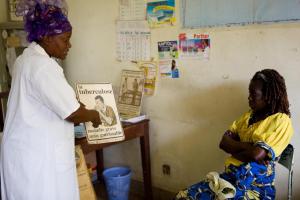COVID-19 pandemic slows progress against tuberculosis
Brazzaville – The COVID-19 pandemic’s disruption to health services has seen an increase in tuberculosis deaths in Africa, the first such rise in more than a decade, while the decline in new cases slowed down, an analysis by World Health Organization (WHO) shows.
The African region has made progress against tuberculosis, reducing cases by 19% between 2015 and 2020—reflecting a decline of 4–10% per year in South Africa and several other in southern Africa countries. However, the region reported 549 000 deaths in 2020, an increase of around 2000 over 2019 and while cases fell modestly by 2.5% in 2020 from 1.4 million the previous year, there were significant drops in reporting of new infections in countries with high tuberculosis burden including Angola, South Africa and Zimbabwe—all of which have grappled with high COVID-19 cases.
Reallocation of resources and health workforce to tackle COVID-19 in many African countries as well as drastic pandemic response measures such as lockdowns greatly reduced access to key health services including tuberculosis diagnosis and treatment. The African region is home to 17 of the 30 countries globally that have the highest burden of tuberculosis and the trend seen in the region follows a rise in tuberculosis cases worldwide due to the COVID-19 impact
“The pandemic has put progress against tuberculosis on the line,” said Dr Matshidiso Moeti, WHO Regional Director for Africa. “Although times are hard and efforts strained by the race to overcome COVID-19, African governments must work harder now to revamp and improve access to essential health services.”
The WHO End Tuberculosis Strategy sets key targets to end the disease. Countries should aim for a 90% reduction in tuberculosis deaths and an 80% reduction in case by 2030 compared with 2015. The strategy outlines key milestones for countries to reach by 2020 and 2025.
The 2020 milestone seeks a 35% reduction in tuberculosis deaths and 20% decline in cases. A WHO scorecard released today on the 2020 milestone finds that only eight countries—Botswana, Cabo Verde, Eswatini, Ethiopia, Kenya, Namibia, South Africa and Togo—met or exceeded the 20% reduction target.
Thirteen countries achieved the target to reduce deaths by 35% in 2020, according to the scorecard. However, the analysis also found that there were significant data gaps in key areas due in part to the challenges posed by the pandemic. Although most countries do not report data on tuberculosis preventive treatment especially for people living with HIV, five countries namely—Kenya, Malawi, Nigeria, Uganda, Zimbabwe—exceeded the target.
The scorecard also measures the proportion of households experiencing catastrophic costs due to tuberculosis. Patients and their households can face severe direct and indirect financial and economic costs that pose barriers that can greatly affect their access to diagnosis and treatment. Eight countries completed the tuberculosis cost surveys for 2020. No country has yet demonstrated that it has met the target that no tuberculosis-affected households face catastrophic costs.
Tuberculosis is the leading killer of people with HIV and the African region has the highest burden of HIV-associated tuberculosis. Factors including insufficient funding for programmes, limited access to modern diagnostic tools as well as low implementation of preventive treatment hinder progress against the disease.
Addressing factors such as poor living and working conditions as well as risk factors including HIV infection, malnutrition, diabetes, smoking and alcohol abuse have the potential to drive down the tuberculosis epidemic. This is possible through collaborative efforts involving the health sector, other government bodies, the private sector, non-governmental organizations donors and communities.
“Reining in this preventable, curable disease calls for matching resources to political will. We need to increase investment in diagnosis and treatment to get back on track,” Dr Moeti said.
Despite the challenges, there has been progress on other key indicators. For instance, most African countries have met or exceeded the goal of providing at least 90% of HIV-positive tuberculosis patients with antiretroviral treatment during their treatment for tuberculosis. In five countries—Burundi, Mauritius, Sao Tome and Principe, Seychelles and Sierra Leone—100% of HIV-positive tuberculosis patients were reported as having started or continued antiretroviral treatment while being treated for tuberculosis.
Additionally, treatment success rate for new and relapse cases have also surpassed 90% in Burundi, the Democratic Republic of the Congo, Eritrea, Ethiopia, Mozambique, Senegal and Tanzania.
Communications and marketing officer
Tel: + 242 06 520 65 65 (WhatsApp)
Email: boakyeagyemangc [at] who.int (boakyeagyemangc[at]who[dot]int)
Communications Manager
WHO Regional Office for Africa
Email: okas [at] who.int (okas[at]who[dot]int)
Tel: +242 06 508 1009



